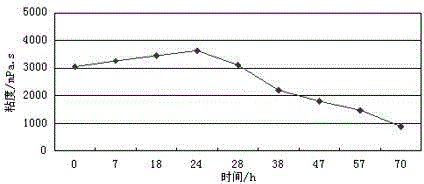A kind of preparation process of negative electrode slurry for lithium ion battery
A lithium-ion battery, negative electrode slurry technology, applied in battery electrodes, circuits, electrical components, etc., can solve the problems of poor dispersion effect, powder drop and sticking roller, unstable viscosity, etc., to solve the problem of powder drop and improve wetting The effect of improving the dispersion effect
- Summary
- Abstract
- Description
- Claims
- Application Information
AI Technical Summary
Problems solved by technology
Method used
Image
Examples
Embodiment 1
[0026] The preparation process of the lithium-ion battery negative electrode slurry in this embodiment includes the following steps in sequence.
[0027] (1) Selection includes 94 parts by weight of negative active material, 5.2 parts by weight of binder, 1.4 parts by weight of thickener, 2 parts by weight of conductive agent, parts by weight of 94 parts of solvent and 5.5 parts by weight of additives are used as raw materials, wherein the negative electrode active material is graphite, the binder is styrene-butadiene rubber emulsion, the thickener is sodium carboxymethyl cellulose, and the conductive agent is conductive Carbon black, the solvent is water, and the additive is N-methylpyrrolidone. Among them, the solvent is preferably deionized water. The parts by weight of the negative electrode active material in the present invention is usually 88 parts-96 parts, the parts by weight of the binder is usually 4.8 parts-6 parts, the parts by weight of the thickener is usually ...
Embodiment 2
[0036] The preparation process of the lithium-ion battery negative electrode slurry in this embodiment includes the following steps in sequence.
[0037] (1) Selection includes 90 parts by weight of negative active material, 6 parts by weight of binder, 1.6 parts by weight of thickener, 5.4 parts by weight of conductive agent, parts by weight of 100 parts of solvent and 3 parts by weight of additives are used as raw materials, wherein the negative electrode active material is graphite, the binder is styrene-butadiene rubber emulsion, the thickener is sodium carboxymethyl cellulose, and the conductive agent is conductive Carbon black, the solvent is water, and the additive is N-methylpyrrolidone. Among them, the solvent is preferably deionized water.
[0038] (2) Add the thickener in step (1) into the solvent to obtain mixed liquid A. The mixed liquid A is stirred at a high speed for 2.5-4.5 hours at a temperature of 30-40°C. The mixed liquid A is heated by circulating heat T...
Embodiment 3
[0044] The preparation process of the lithium-ion battery negative electrode slurry in this embodiment includes the following steps in sequence.
[0045] (1) Selection includes 92 parts by weight of negative active material, 5.4 parts by weight of binder, 1.5 parts by weight of thickener, 3.8 parts by weight of conductive agent, parts by weight of 85 parts of solvent and 4 parts by weight of additives are used as raw materials, wherein the negative electrode active material is graphite, the binder is styrene-butadiene rubber emulsion, the thickener is sodium carboxymethyl cellulose, and the conductive agent is conductive Carbon black, the solvent is water, and the additive is N-methylpyrrolidone. Among them, the solvent is preferably deionized water.
[0046] (2) Add the thickener in step (1) into the solvent to obtain mixed liquid A. The mixed liquid A is stirred at a high speed for 2.5-4.5 hours at a temperature of 30-40°C. The mixed liquid A is heated by circulating heat ...
PUM
 Login to View More
Login to View More Abstract
Description
Claims
Application Information
 Login to View More
Login to View More - Generate Ideas
- Intellectual Property
- Life Sciences
- Materials
- Tech Scout
- Unparalleled Data Quality
- Higher Quality Content
- 60% Fewer Hallucinations
Browse by: Latest US Patents, China's latest patents, Technical Efficacy Thesaurus, Application Domain, Technology Topic, Popular Technical Reports.
© 2025 PatSnap. All rights reserved.Legal|Privacy policy|Modern Slavery Act Transparency Statement|Sitemap|About US| Contact US: help@patsnap.com


